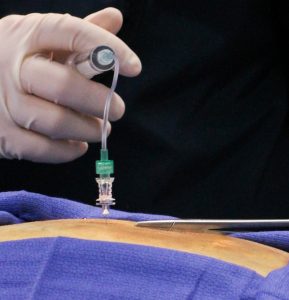What you need to know about back and shooting leg pain treatment.

When someone has low back pain shooting down their thigh or leg a steroid injection can help decrease inflammation, reduce pain and increase quality of life. At this time there is fair evidence to show that a lumbar epidural steroid injection done with the transforaminal approach can be helpful and is superior to the interlaminal or caudal approach.
Glossary:
Transforaminal injection: A transforaminal injection is an injection of steroid into the opening at the side of the spine where a nerve roots exits.
Interlaminar injection: An interlaminar injection is an injection of steroid in the middle opening of the spine.
Caudal injection: A caudal injection is an injection into the lowest portion of the epidural space. A caudal steroid injection can help reduce lower back and leg pain caused by sciatica, herniated discs, bone spurs or other back problems. You have nerves that run from your spinal cord out to your back and legs.
The Research:
PM R. 2009 Jul;1(7):657-68. doi: 10.1016/j.pmrj.2009.04.008.
Efficacy of lumbosacral transforaminal epidural steroid injections: a systematic review.
Roberts ST1, Willick SE, Rho ME, Rittenberg JD.
- 1Christiana Spine Center, MAP 2, Suite 3302, 4735 Ogletown-Stanton Road, Newark, DE 19713, USA. scottrobertsmd@yahoo.com
Abstract
OBJECTIVE:
To critically review the best available studies evaluating the efficacy of lumbosacral transforaminal epidural steroid injections (TFESIs) in the treatment of radicular pain.
DATA SOURCES:
MEDLINE, EMBASE, and the Cochrane database were searched for the period between 1950 and May 2008. Search terms included epidural steroid injection (ESI), transforaminal ESI, foraminal ESI, selective nerve root block, nerve root injection (NRI), selective NRI, periradicular infiltration, and periradicular injection. Randomized controlled trials (RCTs), published in English, which evaluated the efficacy of fluoroscopically guided TFESIs were reviewed.
STUDY SELECTION:
Studies were analyzed with a quality checklist modeled after the 2001 CONSORT Statement: Revised Recommendations for Improving the Quality of Reports of Parallel-Group Randomized Trials. Nine studies were found to include a majority of these items.
DATA EXTRACTION:
Data included study design, inclusion criteria, symptom duration, randomization protocol, blinding protocol, intervention, control, outcomes, follow-up, dropout, statistical analysis, and conclusions.
DATA SYNTHESIS:
Each article was assigned a level of evidence: I (high-quality RCT) or II (RCT with <80% follow-up, no blinding or improper randomization). Studies were divided according to control, and overall evidence was graded as A (good), B (fair), C (conflicting/poor quality), or I (insufficient).
CONCLUSIONS:
There is fair evidence supporting TFESIs as superior to placebo for treating radicular symptoms. There is good evidence that TFESIs should be used as a surgery-sparing intervention, and that TFESIs are superior to interlaminar ESIs (ILESIs) and caudal ESIs for radicular pain. In patients with subacute or chronic radicular symptoms, there is good evidence that a single TFESI has similar efficacy as a single transforaminal injection of bupivacaine or saline. Future studies should address the ideal number of injections. While more placebo-controlled trials are needed to conclusively define the role of TFESIs, current studies support their use in the treatment of lumbosacral radicular pain.











